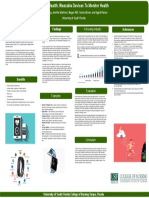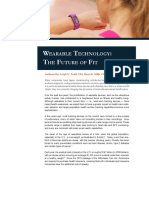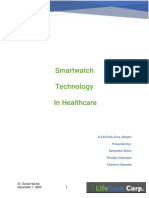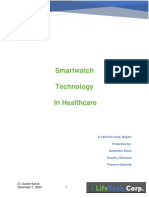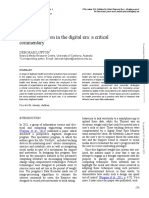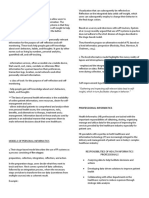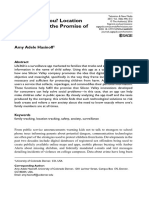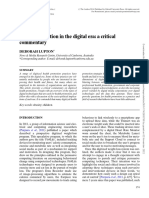Opinion
VIEWPOINT
Wearable Devices as Facilitators, Not Drivers,
of Health Behavior Change
Mitesh S. Patel, Several large technology companies including Apple, Identifying and Addressing the Gaps
MD, MBA, MS Google, and Samsung are entering the expanding mar- Using wearable devices to effectively promote health be-
Philadelphia VA ket of population health with the introduction of wear- havior change is a complex, multistep process. First, a
Medical Center,
able devices. This technology, worn in clothing or acces- person must be motivated enough to want a device and
University of
Pennsylvania, sories, is part of a larger movement often referred to as be able to afford it; this is a challenge, because some de-
Philadelphia. the “quantified self.” The notion is that by recording and vices can cost hundreds of dollars. Perhaps for these rea-
reporting information about behaviors such as physical sons, wearable devices seem to appeal to groups that
David A. Asch, activity or sleep patterns, these devices can educate and might need them least. In a survey of wearable device
MD, MBA
motivate individuals toward better habits and better users, 75% described themselves as “early adopters of
Philadelphia VA
Medical Center, health. The gap between recording information and technology,” 48% were younger than 35 years, and 29%
University of changing behavior is substantial, however, and while reportedly earn more than $100 000 annually.4 The in-
Pennsylvania, these devices are increasing in popularity, little evi- dividuals who might have the most to gain from these
Philadelphia.
dence suggests that they are bridging that gap. devices are likely to be older and less affluent. To better
Kevin G. Volpp,
Only 1% to 2% of individuals in the United States have engage these individuals, wearable devices must be
MD, PhD used a wearable device, but annual sales are projected to more affordable, or new funding mechanisms are
Philadelphia VA increase to more than $50 billion by 2018.1 Some of these needed. For example, employers and insurers might pay
Medical Center,
devices aim at individuals already motivated to change for a device that helps individuals better adhere to their
University of
Pennsylvania, their health behaviors. Others are being considered by medications, potentially yielding significant down-
Philadelphia. health care organizations, employers, insurers, and clini- stream health care savings. Or, devices that demon-
cians who see promise in using these devices to better en- strate effectiveness could be financed in a manner simi-
gage less motivated individuals. Some of these devices lar to that for prescription drugs.
may justify that promise, but less because of their tech- Second, once a device is acquired, a person needs
Author Reading at nology and more because of the behavioral change strat- to remember to wear it and occasionally recharge it—
jama.com
egies that can be designed around them. additional behaviors required from individuals who may
Most health-related behaviors such as eating well have a difficult time already. Many wearable devices re-
and exercising regularly could lead to meaningful im- quire data to be sent to a phone or computer, adding ad-
provements in population health only if they are sus- ditional steps and more equipment. According to one
tained. If wearable devices are to be part of the solu- survey (n = 6223), more than half of individuals who pur-
tion, they either need to create enduring new habits, chased a wearable device stop using it and, of these, one-
turning external motivations into internal ones (which third did so before 6 months.5 One potential solution
is difficult), or they need to sustain their external moti- might be to better leverage smartphones; most people
vation (which is also difficult). This requirement of sus- with these phones carry them often. Ideally, using a
tained behavior change is a major challenge, but many smartphone does not require any effort beyond setup—
mobile health applications have not yet leveraged prin- like an app that gets its power from the phone that
ciples from theories of health behavior.2 people are already accustomed to regularly charging. Be-
Feedback loops could be better designed around cause data can be transmitted passively via a cellular con-
wearable devices to sustain engagement by using con- nection, there is no need for individuals to actively up-
cepts from behavioral economics.3 Individuals are of- date their data. Although smartphones are expensive,
ten motivated by the experience of past rewards and the many people already have them, and the reach of these
prospect of future rewards. Lottery-based designs le- devices is increasing.
verage the fact that individuals tend to assign undue Third, the device must be able to accurately track
weight to small probabilities and are more engaged by its targeted behavior. Accelerometers, commonly found
intermittent variable rewards than with constant rein- within wearable devices, have been well studied for
forcement. Anticipated regret, an individual’s concern tracking step counts. However, newer technologies, such
or anxiety over the reward he or she might not win, can as those that measure heart rate or sleep patterns, have
have a significant effect on decision making. Feedback not been well validated. Similar to mobile health appli-
could be designed to use this concept by informing in- cations, the increase in the availability and types of wear-
Corresponding
Author: Mitesh S.
dividuals what they would have won had they been ad- able devices has not been matched by appropriate test-
Patel, MD, MBA, MS, herent to the new behavior. Building new habits may be ing or oversight to make sure they work.6 Wearable
423 Guardian Dr, best facilitated by presenting frequent feedback with ap- devices are unlikely to have the same capabilities as
Blockley Hall,
propriate framing and by using a trigger that captures home devices that measure blood pressure or track
12th Floor,
Philadelphia, PA 19104 the individual’s attention at those moments when he or medication adherence. However, a smartwatch may fa-
(mpatel@upenn.edu). she is most likely to take action. cilitate feedback from these devices, forming a better
jama.com (Reprinted) JAMA February 3, 2015 Volume 313, Number 5 459
Copyright 2015 American Medical Association. All rights reserved.
Downloaded From: http://jama.jamanetwork.com/ by a Penn State Milton S Hershey Med Ctr User on 05/26/2015
� Opinion Viewpoint
feedback loop than a home device could do alone. For example, a leverage team-based designs and social norms feedback. Indi-
medication bottle that glows red when a medication dose has been viduals form teams that provide peer support and promote a
missed has little effect on an individual who does not see it. A wear- sense of accountability to use the device and stay engaged in the
able device could help facilitate this feedback to the individual by new behavior—perhaps aiming for everyone to achieve a mini-
alerting him or her in real time—or, even better, by alerting the per- mum amount of activity (eg, 7000 steps per day), rather than
son when he or she is in proximity to the bottle and can take the medi- simply rewarding the power walkers. For example, teams might
cation and close the loop immediately. be selected at random in a regular drawing, but winning teams
Fourth, assuming information is collected accurately, it must would only be eligible to collect their reward if the team had
be presented back to the user in a manner that can be under- achieved its targeted behavior on the previous day. This design
stood, that motivates action, and that sustains that motivation leverages concepts of variable rewards and anticipated regret,
toward improved health. Sustaining change may be relatively which have been demonstrated to motivate behavior change.3
easy for the already motivated, quantified-self audience, but is
likely to be difficult for the much larger group of persons with Conclusions
difficult-to-manage chronic health conditions. Workplace well- Although wearable devices have the potential to facilitate health be-
ness programs may offer an environment to deploy interventions havior change, this change might not be driven by these devices
using wearable devices that leverage concepts from behavioral alone. Instead, the successful use and potential health benefits re-
economics.3 For instance, some current strategies by employers lated to these devices depend more on the design of the engage-
may focus on individual-based competitions and displaying lead- ment strategies than on the features of their technology. Ulti-
erboards. These strategies tend to encourage the top performers, mately, it is the engagement strategies—the combinations of
who may already be active and motivated, while discouraging the individual encouragement, social competition and collaboration, and
majority of others who need it most. Another approach is to effective feedback loops—that connect with human behavior.
ARTICLE INFORMATION REFERENCES http://www.nielsen.com/us/en/insights/news/2014
Published Online: January 8, 2015. 1. Wang T. The Future of Biosensing Wearables. Rock /tech-styles-are-consumers-really-interested-in
doi:10.1001/jama.2014.14781. Health website. http://rockhealth.com/2014/06 -wearing-tech-on-their-sleeves.html. March 20, 2014.
/future-biosensing-wearables. June 9, 2014. Accessed Accessed July 15, 2014.
Conflict of Interest Disclosures: All authors have
completed and submitted the ICMJE Form for July 15, 2014. 5. Ledger D, McCaffrey D. Endeavour Partners
Disclosure of Potential Conflicts of Interest. Dr Asch 2. Conroy DE, Yang CH, Maher JP. Behavior change Report: Inside Wearables: How the Science of
reported that he is co-owner and principal of VAL techniques in top-ranked mobile apps for physical Human Behavior Change Offers the Secret to
Health. Dr Volpp reported receiving a grant payable activity. Am J Prev Med. 2014;46(6):649-652. Long-term Engagement. Endeavour website.
to his institution from the National Institutes of http://endeavourpartners.net/assets/Wearables
3. Loewenstein G, Asch DA, Volpp KG. Behavioral -and-the-Science-of-Human-Behavior-Change-EP4
Health; serving as a consultant for CVS Caremark; economics holds potential to deliver better results
receiving grants or grants pending from CVS .pdf. January 2014. Accessed July 15, 2014.
for patients, insurers, and employers. Health Aff
Caremark, Humana, Weight Watchers, and (Millwood). 2013;32(7):1244-1250. 6. Powell AC, Landman AB, Bates DW. In search of
Discovery (South Africa); and that he is a co-owner a few good apps. JAMA. 2014;311(18):1851-1852.
of VAL Health. Dr Patel reported no disclosures. 4. Nielsen CLR. Are Consumers Really Interested in
Wearing Tech on Their Sleeves? Nielsen website.
460 JAMA February 3, 2015 Volume 313, Number 5 (Reprinted) jama.com
Copyright 2015 American Medical Association. All rights reserved.
Downloaded From: http://jama.jamanetwork.com/ by a Penn State Milton S Hershey Med Ctr User on 05/26/2015









